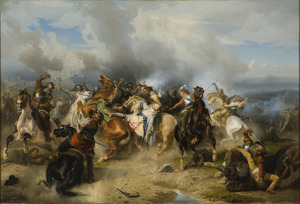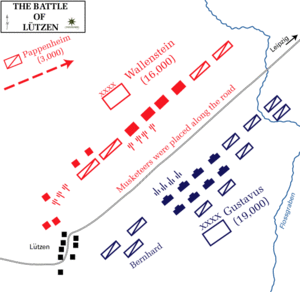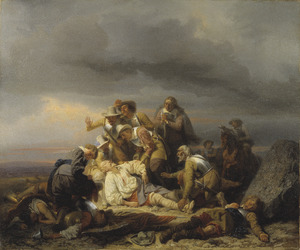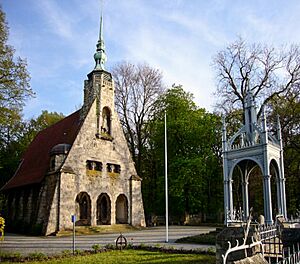Battle of Lützen (1632) facts for kids
Quick facts for kids Battle of Lützen |
|||||||
|---|---|---|---|---|---|---|---|
| Part of the Thirty Years' War | |||||||
 Death of Gustav II Adolph at the Battle of Lützen (1855) by Carl Wahlbom |
|||||||
|
|||||||
| Belligerents | |||||||
| Commanders and leaders | |||||||
|
|
||||||
| Strength | |||||||
| 19,175 total 43 guns |
18,738 60 guns |
||||||
| Casualties and losses | |||||||
| 5,160 killed, wounded or captured 24 guns, and 20 ammunition wagons captured |
6,000 killed or wounded | ||||||
The Battle of Lützen was a very important fight during the Thirty Years' War. It happened on November 6, 1632. A combined army of Swedish and German soldiers, led by King Gustavus Adolphus, fought against an army from the Holy Roman Empire. The Imperial army was led by Albrecht von Wallenstein.
The Swedish-German side won, but both armies lost many soldiers. King Gustavus Adolphus was killed during the battle. Even though they lost their king, the Swedes kept fighting. They formed a new group called the Heilbronn League with their German allies.
Contents
Why the Battle of Lützen Happened
The Thirty Years' War was a long conflict in Europe. It involved many countries and was fought for different reasons, including religion and power.
Sweden Joins the War
Sweden joined the war in June 1630. King Gustavus Adolphus led about 18,000 soldiers into Duchy of Pomerania. France helped Sweden by giving them money. Sweden also had allies like Saxony and Brandenburg-Prussia.
Gustavus Adolphus won important battles. He defeated Imperial armies at Breitenfeld in September 1631. He also won at Rain in April 1632. These wins took him deep into southern Germany.
Wallenstein's Strategy
The Imperial general, Albrecht von Wallenstein, moved his army to Fürth. He wanted to cut off Gustavus's supply lines. On September 3, the biggest battle of the war happened. The Swedes attacked Wallenstein's camp but were pushed back. This was a big mistake for Gustavus.
After this, Wallenstein joined Heinrich Holk to attack Saxony. They hoped to make Saxony leave the war. They captured Leipzig in early November. Wallenstein decided to stay there for the winter.
Gustavus Decides to Attack
On November 15, the Swedes learned something important. A part of Wallenstein's army, about 5,800 men, had left. This group was led by Pappenheim and went to Halle. This left Wallenstein with fewer soldiers, about 13,000 to 15,000 men.
Gustavus Adolphus had about 19,000 soldiers. This meant he had more men than Wallenstein. So, Gustavus decided to attack. He quickly moved his army from his base at Naumburg. His army included soldiers from Sweden, Hesse-Kassel, and some from Saxony.
Setting the Stage for Battle
Late on November 5, the Swedes met an Imperial outpost near the Rippach stream. This was about 5–6 kilometers south of Lützen. Wallenstein quickly told Pappenheim to return with his troops. Pappenheim got the message after midnight and rushed back with his cavalry. His infantry followed behind.
The Swedes stopped about two kilometers outside Lützen. They set up their camp ready for battle. The Imperial troops worked all night. They built defenses along the main Lützen-Leipzig road, also known as the Via Regia. The land was mostly flat. But Wallenstein placed his right side on a small hill with three windmills. This hill also held his main artillery (cannon) battery.
The Battle of Lützen Begins
The Swedish attack was delayed. First, there was a thick morning mist. Then, they had to cross the Flossgraben canal. Because of these delays, their attack didn't start until 11:00 am. This delay gave Pappenheim enough time to arrive with his cavalry. This meant the Swedes no longer had more soldiers at the start of the fight.
Early Attacks and Pappenheim's Arrival
Bernhard of Saxe-Weimar, a Swedish commander, did not make much progress against Wallenstein's right side. But King Gustavus Adolphus was more successful. He pushed back Imperial musketeers (soldiers with guns) from a ditch along the Lützen-Leipzig road. He crossed the road and then moved to attack the Imperial left side from the flank.
Around 12:00 pm, Pappenheim arrived with 2,300 cavalry soldiers. He immediately charged the Swedish infantry. He pushed them back across the road. Some of the best Swedish units were almost completely destroyed. They lost up to 65% of their soldiers.
The Imperial troops also lost many soldiers. Many of their senior officers were killed or badly hurt. Pappenheim himself was fatally wounded. He died while being taken away in a coach. At the same time, Holk attacked the Swedish center. By 1:00 pm, both armies were getting disorganized. The battle became a confused series of small fights.
The Death of Gustavus Adolphus
Officers on both sides tried to reorganize their troops. Smoke from burning houses in Lützen made it hard to see. King Gustavus Adolphus was trying to rally his soldiers. He and his group got lost and ran into an Imperial cavalry unit. He was shot three times and fell dead from his horse. His body was not found until after the fighting ended that evening.
News of Gustavus's death spread quickly among the Swedish army. But Wallenstein did not believe it. Many of his own troops were also in bad shape. A lot of Pappenheim's cavalry ran away. They told the infantry coming from Halle that the battle was lost. However, the infantry kept marching towards Lützen. Some Imperial units even looted their own supply wagons.

The Battle Continues
There are not many clear accounts of the second part of the battle. It is harder to know exactly what happened. Some say Knyphausen, a Swedish commander, suggested retreating. But Bernhard of Saxe-Weimar kept attacking the Imperial left. So, Knyphausen moved his troops forward and crossed the Via Regia again.
As they crossed, they captured a small cannon battery in the center. They used these cannons to fire at the Imperial left side, which slowly moved out of range. Around 4:00 pm, Bernhard of Saxe-Weimar finally took control of Lützen. Then, he captured the main Imperial cannon battery near the windmills. He turned these cannons on the retreating Imperial soldiers.
By 5:00 pm, it was getting dark. Wallenstein ordered his troops to retreat. They left the battlefield to the Swedes. He had to leave behind his remaining cannons and supply wagons. This was because he had lost his horses that pulled them. Pappenheim's infantry, about 2,900 strong, arrived after dark. They wanted to counterattack. But Wallenstein ordered them to cover his retreat into Leipzig instead. The Swedes finally found the body of their king. It was under a pile of dead bodies on the Imperial side of the ditch. This ditch had seen very heavy fighting all day.
After the Battle
The Imperial army lost about 5,160 soldiers killed or wounded. The Swedish army lost around 6,000. Wallenstein decided he could not hold Leipzig. He retreated into Bohemia. He left behind over 1,200 wounded soldiers, who were taken prisoner. During his retreat, Saxon farmers attacked the Imperial soldiers. The farmers were angry because their crops were destroyed. Wallenstein's army suffered more losses during this retreat.
Wallenstein's retreat and the capture of his cannons allowed the Swedes to say they won the Battle of Lützen. They also achieved their goal of forcing him out of Saxony. However, the most important result of the battle was the death of King Gustavus Adolphus.
Impact of Gustavus's Death
People in Sweden and other Protestant countries in Europe were very sad about Gustavus's death. But his allies felt differently. Cardinal Richelieu, a French leader, had given money to support the Swedish army. He had often disagreed with Gustavus about war plans. Some people even rumored that Richelieu was involved in Gustavus's death. There is no proof of this. But Gustavus's death meant France became the main leader of the group fighting against the Habsburgs.
Saxony and Brandenburg were tired of their alliance with Sweden. The war had caused many civilians to die from disease and hunger. Sweden's control of Swedish Pomerania also threatened their trade in the Baltic Sea.
Sweden Continues the War
Gustavus was succeeded by his six-year-old daughter, Christina. So, the Privy Council of Sweden took over leading the country. Axel Oxenstierna became the Chancellor in January 1633. He decided that Sweden needed to continue the war. This was to get enough payment for their efforts.
Oxenstierna made sure he controlled the army. Then, he created a more formal group of allies. This was to make the Swedish state stronger. He also had doubts about how reliable his allies were.
France started paying money to Sweden again on April 7. On April 27, Sweden and its German Protestant allies formed the Heilbronn League. Oxenstierna was put in charge of the League. He had the final say on military matters. He was helped by ten advisors, three of whom were Swedish.
The members of the League agreed to support an army of 78,000 men. But they provided less than a third of the money needed. France paid the rest directly to Sweden. This gave France control over the League. The German states agreed to keep fighting until Sweden got "fair payment." Oxenstierna promised them that their borders would return to how they were before 1618. In July, the League defeated an Imperial army at Oldendorf. Wallenstein was accused of not helping his colleague. There were also rumors he might switch sides. Because of this, Imperial agents removed him from his position and killed him in February 1634.
Legacy of Lützen
The day after the battle, a large granite rock was placed where Gustavus Adolphus fell. It is called the Schwedenstein (Swedish Stone). In 1832, an iron cover was put over the stone. A chapel was built nearby in 1907.
The battle was fought on November 16 according to the Gregorian calendar. But it was November 6 according to the Julian calendar, which Sweden used then. Even though Sweden uses the Gregorian calendar now, they still celebrate Gustavus Adolphus Day on November 6 each year.
In 2011, a mass grave was found. It held the remains of 47 soldiers. This was in an area where a Swedish unit, the Blue Brigade, was reportedly attacked by Pappenheim's cavalry. Studies showed the soldiers were about 28 years old on average. They had old injuries, meaning they were experienced fighters. More than half had been hit by gunfire. This was a very high number for that time.
Sources




